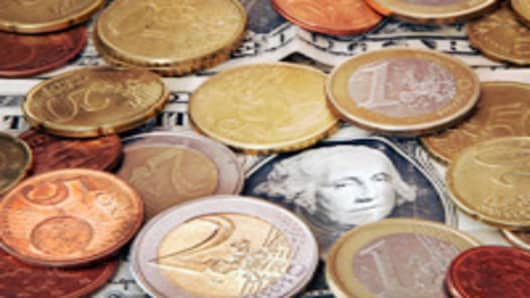The dollar fell against most major currencies Friday after data showing sharp declines in consumer sentiment and New York area manufacturing rekindled fear that the economy continues to slouch toward recession.
Investors pushed the dollar down against the euro for the fifth day in the last six, pushing the euro zone currency above $1.47 for the first time since Feb. 5, after a gauge of U.S. consumer sentiment plunged to a 16-year low in February.
The euro was up slightly on the day versus the dollar, after climbing as high as $1.4709, according to Reuters data.
The dollar also fell against the yen after the New York Federal Reserve said its February manufacturing index posted the biggest monthly decline on record.
The data "is very, very negative, and it's going to be difficult to avoid negative U.S. growth in the first quarter," said Michael Woolfolk, senior FX strategist at The Bank of New York Mellon.
He said that sets the euro up for a run at its record high just shy of $1.50, particularly with the Federal Reserve seen cutting interest rates further below the European Central Bank's benchmark interest rate.
Indeed, Friday's batch of grim data comes a day after Fed Chairman Ben Bernanke warned of continued sluggish growth in the near term and said the central bank will act as needed to provide insurance against downside risks.
Since mid September, the Fed has slashed its benchmark rate by 2.25 percentage points to 3 percent. Bernanke's remarks and recent economic data have left investors betting on another half percentage point cut at the central bank's March meeting.
But expectations for the ECB to follow with rate cuts of its own have faded, with ECB officials stressing that inflation is a bigger concern than growth.
That has continued to move rate spreads in favor of the euro, reducing the appeal of holding U.S. over euro-zone debt.
Two-year Treasury note yields have slipped five basis points this week, while the yield on comparable German debt is up seven basis points, leaving it 129 basis points higher.
After dipping to around $1.4440 last week, the euro has retraced more than half of the ground it lost since rising above $1.49 on Feb. 1. Though still weaker versus the dollar so far in February, it has gained 1.2 percent this week.
The dollar also fell versus the Swiss franc . Sterling was the only major currency to weaken against the dollar, with dealers citing technical factors for the pullback.
Some analysts worried that inflation may not be only a European phenomenon. The Reuters/University of Michigan consumer sentiment index showed one-year inflation expectations soared to their highest since August 2006.
Separate data on Friday showed U.S. import prices rose by more than economists had expected in January, mainly the result of high food and energy costs.
Alan Ruskin, chief international strategist at RBS Greenwich Capital in Greenwich, Connecticut, said Friday's data "will play to market talk of stagflationary tendencies."
Stagflation refers to a period of high prices and low growth. For the United States, the last severe episode of stagflation was in the 1970s.


